Affiliate disclosure: This post may contain affiliate links. Please see our Privacy Policy.
Mango jam captures the sunny, tropical flavor of fresh mangoes for year-round use. Can up this simple mango preserve for a shelf-stable jam, or simply store it in the refrigerator for immediate use. Either way, mango jam is the perfect way to preserve mangoes.
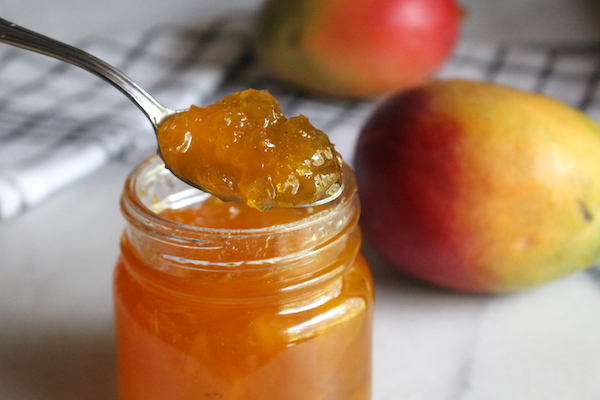
My family absolutely loves mangoes. I’m not just talking casual appreciation, I mean serious deep mango related infatuation. We love mangoes so much that we actually named our homestead “Vermont Mango Plantation,” as a simple homage to the perfect fruit.
Bright and sunny, sweet and juicy…mangoes are everything I could want in a fruit. We have a lovely attached greenhouse, and we were actually growing mango trees in there for a time (until our unruly geese broke in and trashed the place, but that’s another story).
Mangoes are our local currency you see. Mangoes generally cost $1, or at least they did when this home currency was established. Right after we got married, my husband and I would use the “mango test” to determine if we should make a purchase. If something costs $10, we’d ask ourselves…would I rather have this, or 10 mangoes?
More often than not, mangoes won and that’s one way we managed to save enough money to quit our jobs and move to our off-grid homestead. See, a love of mangoes can be life-changing…
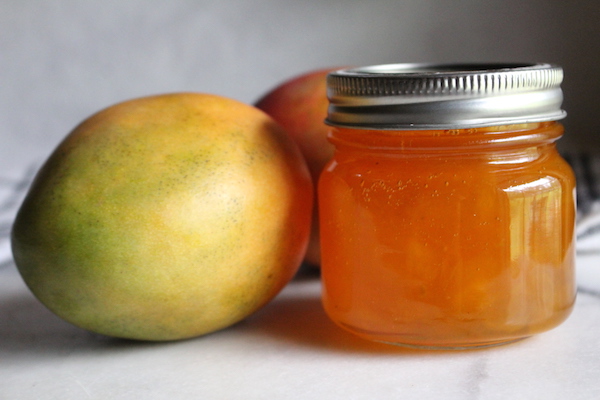
These days, mangoes are often $2 to $3 dollars at the grocery store, and they only make it into our otherwise frugal budget when they go on sale down to a single unit of mango currency…that being $1 each.
When mangoes are $1 though, it’s no holds barred and I’ll buy out the store. I’ve come home with as many as 30 mangoes at once, no shame and no regrets. We’ll binge on them fresh for a few days, then make a batch of thai mango sticky rice and have a mango lassi for breakfast.
After that, a bit of reality sets in and there’s still often 10-15 mangoes left on the counter. Their days are numbered at this point, and it’s time to get to work preserving mangoes so we don’t run out of our favorite currency.
In the past, I’ve usually dehydrated mangoes, and the new Excaliber dehydrator we just got means I can put up a case at a time with 15 square feet of drying space. Dried mango is wonderful as a quick snack, and I’m actually chewing on a piece as I type…because who can write about mangoes without reaching for one?
The thing is though, I wanted a mango preserve that I can use to top sticky rice or make into mango tarts. I often use fresh mango for this, but a simple mango jam would work perfectly.

How to Make Mango Jam
The process is pretty simple, and all you need is chopped mango fruit, sugar and a bit of citrus juice (lemon or lime). Place all of it in a pot and boil hard for about 20 minutes until the jam reaches gel stage (more on that later).
While you can add pectin to speed up the process, and with a bit of patience, mango jam sets beautifully without any added pectin. Of course, if you want a quick mango jam pectin is always an option, but the pectin free method only takes about 20 minutes so it’s not exactly a huge time investment.
Start by chopping the mangoes into rough cubes. While I assumed the mangoes would break down during cooking, they actually held together quite well. The jam was already starting to gel and the mangoes were still whole cubes floating in a translucent mango jelly. I gave them a quick mash so that the jam came out a bit smoother, but you can always leave them chunky.
With that in mind, chop your mango into small-ish chunks, knowing that many of those chunks will remain in your final jam unless you’re really diligent at mango mashing. I’d aim for roughly 1/2 inch cubes.
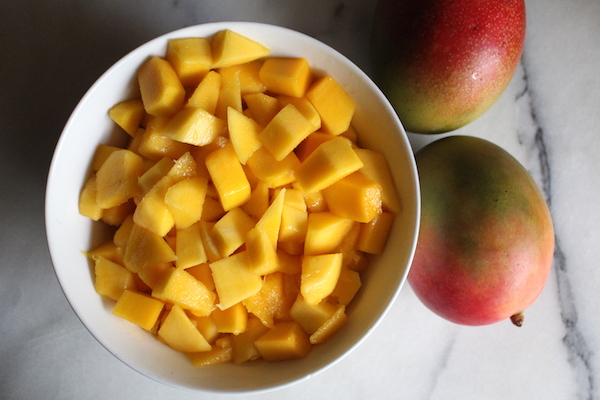
Mangoes are a low pectin fruit, which means they don’t gel as readily as others when you’re making mango jam. Low pectin does not mean no pectin, and they will still create a lovely jam after about 20 minutes of cooking. Really high pectin fruits, like the red currants for my red currant jam, gel into a stiff jam after about 5 minutes. It takes a bit longer, but that’s not the end fo the world.
As a rule, fruits contain more pectin when they’re ever so slightly under-ripe, and mangoes are no exception. Choose firm, but ripe mangoes that still hold together in cubes when sliced. Avoid stringy fruits, as those long fibers will be really annoying in the finished jam.
To boost the pectin content of this mango jam, you need a bit of citrus juice. Citrus fruit are very high pectin, and you can make a simple orange jam with just a bit of orange juice and sugar. Lemon jam is no different, though for practical reasons that one requires a lot more sugar. In mango jam, lemon or lime juice add pectin and help bring out the tropical flavor of the fresh mangoes.
There’s another reason to add citrus juice though…mangoes are low acid fruits. They’re not actually safe for canning without added citrus juice. For that reason, the citrus juice is not optional in this simple mango jam recipe.
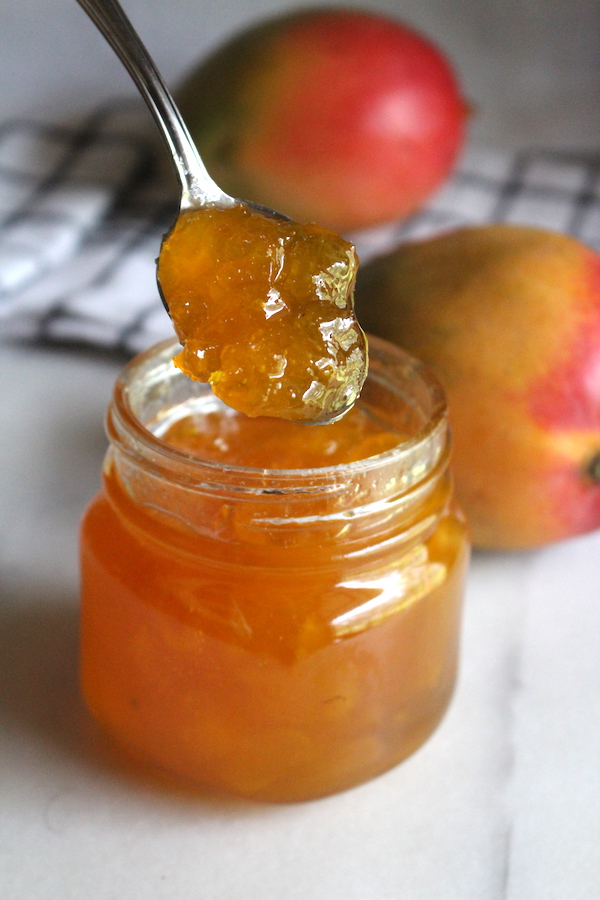
So as I mentioned, just place the mango cubes, sugar and citrus juice in a large heavy-bottomed saucepan. Turn the heat up to high and boil the mixture hard for about 20 minutes, stirring frequently to prevent burning and overflows. The mixture will bubble actively, and you should choose a large-ish pot that’s only about 1/3 full after you’ve added the ingredients. Trust me, mango jam really foams up as it’s cooking and you’ll need the space.
As the jam approaches gel stage, the bubbles and foam will slow down and the surface of the jam will take on a shiny appearance. The texture of the bubble will change, and they’ll be larger and slower to pop. That’s how you know the jam is getting close.
If you’re an experienced jam-maker, you know what gel stage looks like in the pot. There are, however, a few simple ways to double-check. You can test the gel of the jam by spooning a bit of it onto a plate that’s been kept in the freezer. It’ll cool quickly and show you the finished texture of the jam. You can also test it using an instant-read thermometer, cooking the jam until the thermometer reads 220 degrees F.
Keep in mind, if you’re at higher altitude water boils at a lower temperature and gel stage will come at a lower temperature. The rule of thumb is to drop 1 degree off for every 500 feet above sea level. Our house is at about 1000 feet, so we reach gel stage at 218 degrees.
Once your mango jam has reached gel stage, pour it into prepared canning jars leaving 1/4 inch headspace. Cap the jars with 2 part canning lids.
At this point, you can process the mango jam in a water bath canner for 10 minutes for a shelf-stable mango preserve. Alternately, store the jars in the refrigerator and use them within a few weeks, no canning required.
This simple recipe makes 3 half-pint jars, but you can double it for a 6 half-pint batch. Do not increase the recipe more than double though, as large jam batches can have trouble reaching gel stage since they don’t heat evenly.
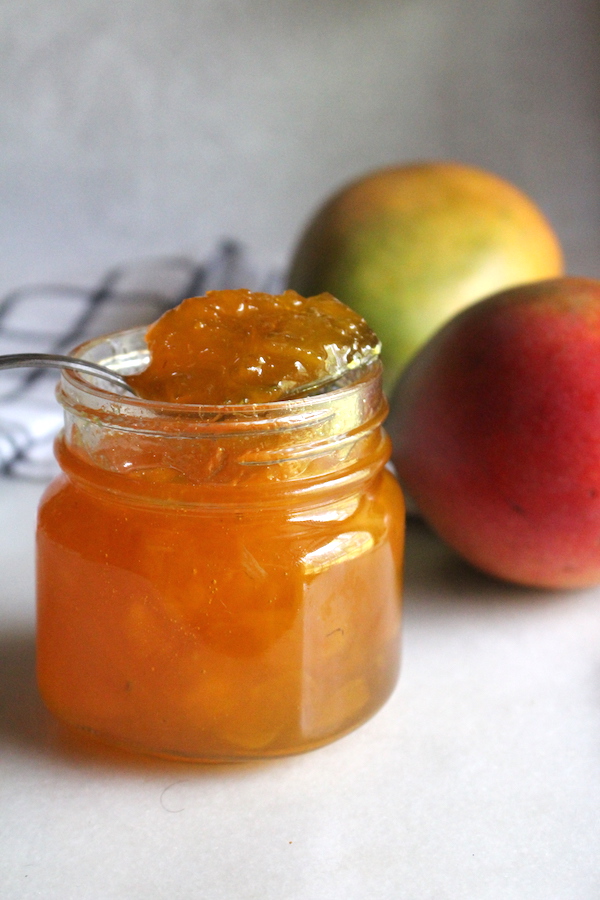
Mango Jam Recipe Variations
If you’d like to try making a low sugar mango jam, you’ll need to add commercial pectin. With less sugar, these low pectin fruits just won’t gel on their own even with added citrus juice. The book Preserving with Pomona’s Pectin has a low sugar mango jam recipe that’s very similar to mine, but it has half the sugar. They use the following:
- 4 cups mango
- 1/2 cup lime juice
- 4 tsp calcium water
- 1 cup sugar
- 3 tsp Pomona’s Pectin Powder
If you’re familiar with Pomona’s low sugar and no sugar pectin, you know that it uses calcium water as an activator and that comes with the boxed pectin. All the instructions you need will be inside the Pomona’s pectin box, but basically, add the calcium water to the fruit, and then add the pectin powder to the fruit. Bring the fruit/citrus mixture to a boil, then add the sugar/pectin mixture and boil hard for 1-2 minutes before pouring into jars.
That same preserving book has a number of mango jam recipe variations, including Mango Ginger Preserves, Orange-Mango-Mint Jelly, Savory Spiced Mango Conserve, Strawberry Mango Jam, and a mixed tropical conserve. Clearly, that author loves mangoes as much as I do!
Flipping through my other home canning books, I found a plethora of mango canning recipes. Here are a few more ideas:
- The Ball Complete Book of Home Preserving has recipes for Mango Chutney, Mango Raspberry Jam, and Canning Mangoes in Syrup.
- Canning For a New Generation includes a recipe for mango jam with lime that’s very similar to mine. The only difference is that the author adds in 1 pound granny smith apples to help the jam gel, but all the other ingredients are the same. The yield is higher, but she also notes that it takes about 20 minutes to reach gel stage. Also included are recipes for Green Mango Chutney with Whole Spices as well as Mango and Peach Habanero Hot Sauce.
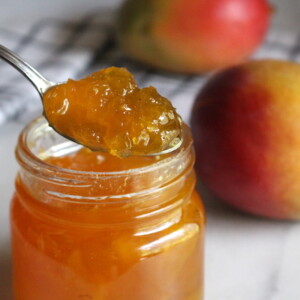
Mango Jam
Ingredients
- 4 cups Mango, chopped, from about 7 large mangoes
- 3 cups Sugar
- 1/2 cup Lime Juice, or lemon juice
Instructions
- Peel, seed and dice mangoes into 1/2 inch cubes. (Place a few small plates into the freezer at this point to use to test for gelling as the jam reaches completion.)
- Place the chopped mangoes into a heavy-bottomed saucepan along with the sugar and citrus juice. Be sure that they only come 1/3rd of the way up the pot at this point to prevent overflows when the mango jam is cooking.
- Bring the ingredients to a boil over medium-high heat, stirring frequently to prevent scorching or overflows.
- Boil hard for about 20 minutes until the jam begins to gel. Test for gelling on a plate that's been chilled in the freezer, or use an instant-read thermometer to check for gel temperature (220 degrees F, or slightly lower at higher altitudes).
- Pour the jam into prepared canning jars leaving 1/4 inch headspace. Process in a water bath canner for 10 minutes, or simply store in the refrigerator for immediate use. Canned jam should last 1 year in the pantry, and refrigerator jam should last 2-3 weeks.
Notes
Other Easy No Pectin Jam Recipes
Looking for more fun canning recipes to try? All of these homemade jam recipes are no pectin and come together with just a few simple ingredients.
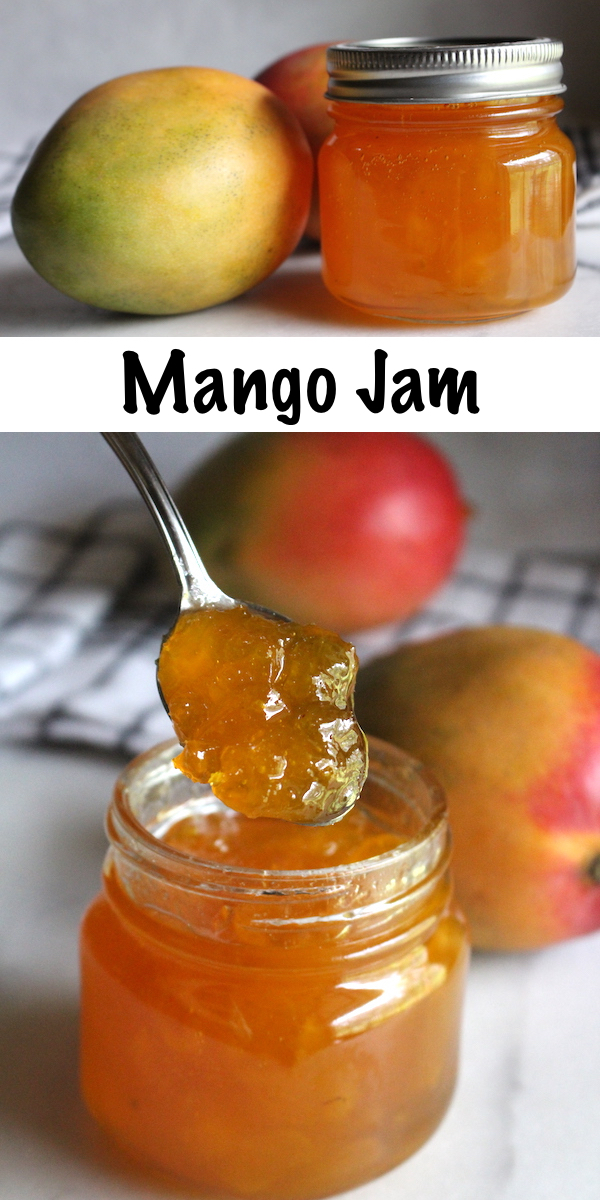

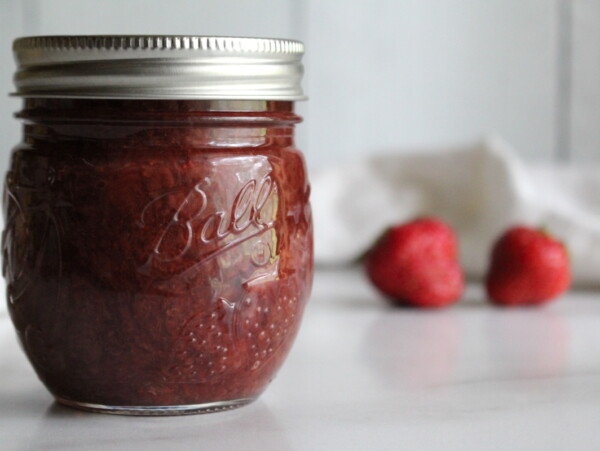


Hi.im going to try your lovely recipe. I thought you might like my recipe for sweet mango Churney:
1lb ripe mango flesh…about 3 large mangoes
I teaspoon chilli powder
2 teaspoons English yellow mustard powder
1 ounce fresh root ginger, peeled and chopped finely
1 ounce garlic chopped
10 fluid ounces white wine vinegar
1lb sugar
1 teaspoon salt
Peel mangoes. Chop flesh into small slices.vput the chilli powder, mustard. Ginger and garlic into a blender and whizz to a paste with a little of the vinegar.
Put the remaining vinegar in a pan add the mango flesh and sugar and simmer until the fruit is just soft, stirring well. Mash some of the flesh ad you stir but keep some intact for texture. Add the spice paste and salt and simmer for another 20 minutes until the chutney is thick. Pack into warm jars, seal when cold.
It will keep for 2-3 months
Makes approximately 2lbs.
Thank you so much for sharing. Sounds delicious.
O M Goodness !!! Sooo Good ! I followed your recipe to the T and it came out Perfectly !
My boiling point here in NE Ohio is 210F, so I boiled to 218F.
I’m enjoying it now on a toasted English Muffin….Perfectly spreadable…
I’ve never made jam without pectin, so I am pleasantly surprised…
Thank You…It’s a Keeper ! 😍
You’re very welcome. So glad you enjoyed it.
Hi! I made this recipe but after I put it in the fridge, it completely hardened 🙁 I heated it in the microwave but I’m going to use it as filling in a cake, so that means it’ll definitely be going back in the fridge after it’s in the cake, and I’m afraid it will just harden inside the cake. Does this mean I cooked it too hot? Is there any way to fix it?
It sounds like it was cooked too much and probably turned into candy. Did you use a thermometer when you made the jam?
I loved jam so much that I constantly use it with my desserts LIKE pies’ cake muffins
Yes, that’s a great way to use up your jams.